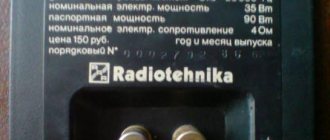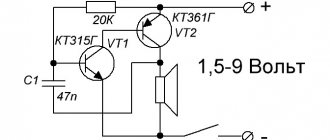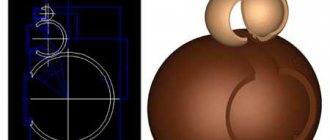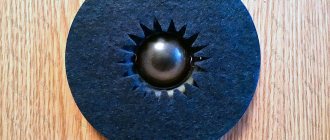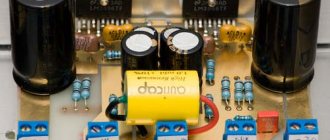Having on hand a number of old and very ordinary Soviet speakers, I wanted to assemble speakers on them (MAS - small-sized speakers) and see what can be obtained from this venture. I think that the design is suitable for repetition, the cost of components is low. If I used rare imported speakers, the possibility of exact repetition would be minimal. The frequency range of the finished speaker is 40…20000 Hz.
↑ Selecting speaker type
With the passage of time and the accumulation of certain experience, I gradually came to the conclusion that two-way is good, but it is difficult to find suitable speakers for it that sound good over a wide enough frequency band.
There are 6GD-2 speakers and some others, but they are in short supply and you definitely can’t make small-sized speakers with them; 6GD-2 require boxes the size of a small refrigerator.
To get a more or less low frequency on the shield, it must be very large, this is also not a MAC. For MAS, only FI remains because, in my opinion, there are no Soviet speakers capable of providing bass in a small ZY.
All the woofers I know have a rubber surround (they had foam rubber, but at the moment they require mandatory replacement of the surrounds, and the volume of the box will be too big for MAC) and they sound bad in the midrange, and these frequencies are very important for me because I think that they determine the overall sound quality.
All Soviet MACs are made using a two-way design, have a high crossover frequency, approximately 5 kHz, and therefore sound inexpressive due to the fact that the “rubber” low-frequency speaker does not sound well above 1...2 kHz.
Most industrial speakers, even those assembled using a three-way design, also sound muddy in the midrange because they usually have a “rubber” 15GD-11 installed. This circumstance is the reason for the huge number of articles on the conversion of 25AC, 35AC and their clones. Therefore, a three-way version with a paper midrange speaker was chosen for the project. In addition, I believe that the best design for a midrange speaker is a shield or a shallow OJ. The shield is preferable in terms of sound, but is inconvenient in design.
Therefore, the choice of column type is as follows:
three-way, woofer in a small box with FI, midrange speaker in a small shallow OJ, tweeter on a tiny shield.
An attempt to “split” the Onkens
An attempt to “split” the Onkens.
The constant desire to optimize the sound of the bass section of a home audio system forces many to consider technical solutions of the past as next options. Among such solutions, acoustic systems such as Jensen (later Onken) stand out noticeably. Forums for DIYers and antique audio enthusiasts actively praise this type of speaker, although some acousticians are skeptical about this relic.
At first glance, it is difficult to attribute this design to a specific, well-known type of acoustic design. In it you can see similarities with a reverse horn, a bass reflex, a resonator, an acoustic impedance panel, and some even see similarities with screen speakers. This article attempts to understand the nature of Jensen-Onken systems and their suitability for high-quality audio reproduction.
It is known that in the era of early audio engineering, speaker designers relied on experimentation, simply placing speakers in different conditions. It is reasonable to assume that for such studies, a model of a case with an adjustable volume, such as a “box in a box,” could become a successful layout, and the gap between its components could become a prototype of a bass-reflex box tunnel. It looks like Jensen also used a sliding box or something similar when creating the Ultraflex acoustics. Be that as it may, but only much later, the researchers managed to provide a scientific basis for the empirical research of their predecessors, determining the relationships between the parameters of the acoustic design and the loudspeaker. Then engineers from Onken (Japan) also mathematically described Jensen's development. They proposed a completely specific calculation method based on standard Thiel-Small parameters, which are still used in the design of acoustic systems. True, in addition to the classical set of parameters, the well-known technique from Onken contains one more, arbitrary parameter - the Onken parameter ( n
).
Apparently, it is intended to introduce a certain “element of creativity” into the calculation, giving the designer the right to individuality. Indeed, this method assumes a direct dependence of the body volume Vb
L
, in turn, depends on the volume .
Vb
and
L
parameters are fundamental and, of course, have a serious impact on the final sound of the system.
The degree and nature of the influence of the n
-parameter needs to be seriously understood.
The latest person to have a hand in the process of conceptualizing the Jensen-Onken design was Canadian Cyr-Marc Debien of Dimensions Acoustiques. He reduced Onken's mathematical model into a convenient modern calculation tool - Onken Calcolatir (Onken Calculator) based on a spreadsheet. If now, using this tool, we try to calculate the speaker housings, with different n
, for a real loudspeaker (SG), for example, Supravox 400GMF, recommended by the manufacturer specifically for Jensen-type speakers, then the results obtained will show that in a certain range of
n
, the calculated changes in the body parameters
Vb
and
L
correspond to the same changes in the acoustic model with adjustable volume " box in a box + tunnel."
Dependences of the theoretical volume and the volume of the model box on n
, subject to the design parameters of the tunnel, is illustrated by graph 1. Indeed, there is a zone (
n
= 5...9) where the volume curves of the physical and mathematical models of the body coincide.
Graph 2 additionally indicates that in the assumed control region, the calculated and experimental data for the parameters Vb
and
L
are almost the same. All this proves that a real sliding drawer can produce satisfactory results in practice.
According to theory, the volume of the body is determined as n
multiplied by a certain value for a specific GG, which is static.
This value is a complex characteristic of the GG. By the way, this characteristic also takes into account the role of the power amplifier as part of the electromechanical system. This role is expressed in its output resistance Rg
, the value of which makes noticeable adjustments to the final result, especially if the amplifier is a tube amplifier (
Rg
= from 1 to 6 Ohms).
Another theoretical setting. According to the method - for a specific speaker, bass reflex tuning frequency Fb
is fixed and does not depend on
n
. Next we will show how this circumstance affects the transmission of low frequencies by acoustics of the type under consideration.
By using computer modeling of acoustic design, using a specialized application, it is possible to compare the frequency response in the low-frequency region for extreme values of n
-parameter - graph 3. The upper value
n
, for clarity, is taken above the permissible control limits (
n=
12.5).
Here you can see minor changes in the frequency response, affecting only the FI tuning zone; they do not exceed 3 dB. If we limit ourselves to the established values of n
(from 5 to 9), then these changes will be even less significant.
It turns out that when transforming the volume in parallel with the depth of the tunnel ( Fb
= const), the frequency response of the system in the low frequency region is minimally affected. The damping properties of the acoustic design are mainly regulated. It is known that the transient characteristics of the emitter, which influence the articulation and nature of the attenuation of sounds, primarily depend on damping.
The air inside the acoustic system, depending on the volume, can have both damping properties, i.e., absorb vibrations, and energy storage properties (like a charged spring that unwinds at the wrong moment). It is very important to create such conditions for the operation of the loudspeaker under which there would be no losses at low signal levels (swallowing of after-sounds), and the nature of the attenuation would convey a real sound picture, without unauthorized bursts and buzzing. This requires a subtle, creative approach. Unfortunately, methods for designing speakers are usually limited only to the issue of ensuring the best amplitude-frequency characteristics - uniformity and broadband. Impulse (transient) characteristics, which are responsible for sound quality, are often ignored. This gap, apparently, is eliminated by introducing the mysterious Onken parameter into the calculation system.
Graph 4 shows the frequency response of the same GG installed in different acoustic designs. Obviously, the infinite screen (EB) provides the widest range towards low frequencies and a slow, monotonous decline in characteristics, which is perceived as comfortable and natural by ear. But the screen, even if not infinite, is a bulky thing and highly dependent on external conditions, therefore it is not universal and is rarely used.
A closed box (CB), as a special case of a BE, is also not bad in terms of the smoothness of the characteristic decay, but is inferior to all design options in the frequency range.
The bass reflex is advantageous both from the point of view of the frequency range and from the point of view of compactness. The optimal box-FI, from the standpoint of uniformity of frequency decay, will have a volume almost 2 times less than the Onken and n
= 3.5. Its disadvantage can be considered too steep a decline in the frequency response. The effectiveness of FI, usually below a certain frequency, sharply decreases, which is audibly perceived as defective (chopped) of the lowest frequency component.
A phase inverter of the Onken type, as can be seen from the same graph, up to a certain point tends to match the frequency response of an infinite screen (This is what brings these types together!), and the steep decline begins much lower in the frequency range than that of the optimal FI. This, of course, is less jarring to the ear. The price to pay for such a low-frequency add-on is no small additional volume. By the way, in the famous article by A. Belkanov about Onken acoustics, a graph with characteristics of Petite-Onken speakers is presented. The decline in this characteristic on the LF side also demonstrates the characteristic feature of the Onken-type bass reflex described above.
So, the range of variation n
lies in the range from 5 to 9. For such
an n
-parameter, a volume change of approximately 1.5 times is required with a double change in the tunnel length. The presented drawing of the speaker housing for the Supravox 400GMF GG fully satisfies the above theoretical calculations, allowing adjustment of the tunnel depth and volume within the required limits and even wider.
The ability to regulate the Onken parameter in practice is a very convenient and useful thing. The main thing is that, within the implemented limits, it is possible to obtain changes regarding the character of the bass sound - from fairly restrained to overly unleashed. This means that the optimum lies somewhere in the middle. Subsequently, in the process of leisurely and repeated listening, not immediately, it is possible to determine a certain intermediate position that most fully corresponds to individual ideas about the correct bass and is best suited to specific external acoustic conditions.
Conclusions:
1) Jansen-Onken speakers - belong to the type of phase-inverted systems with an increased, sometimes much, internal volume.
2) For calculations, it is convenient to use the Onken calculator program, which is available on the Internet.
3) Values of the Onken parameter ( n
), most likely should be in the range from 5 to 9.
4) When making calculations, you should not neglect any of the parameters shown. The value of the output resistance of the signal source ( Rg
), in the case of using a tube amplifier, is also an important quantity that significantly affects the result.
For tube amplifiers, this resistance is always individual, but for most transistor amplifiers, Rg
= 0 can be taken.
5) The ability to quickly change the Onken parameter greatly simplifies the task of achieving the best sound from the speakers themselves and best adapting them to specific operating conditions (room, location, etc.).
6) The main disadvantage of Onken-type speakers (the disadvantages have not yet been mentioned, but how could we live without them) is the presence of distortions that form inside the housing and through a port (tunnel) with a large cross-section that easily reaches the listener. The spectrum of these distortions is in the mid-frequency region. This phenomenon can be combated by narrowing the range of radiation from above using a more efficient crossover, and assigning the midrange to another loudspeaker, or by using a damping material that can reduce the intensity of harmful radiation. By the way, do not forget that damping the internal space of the speaker with sound-absorbing materials is another effective control lever, the degree of influence of which on the sound will have to be determined only experimentally.
In conclusion, to complete the picture, the author of the article should give a subjective assessment of the sound of the considered acoustics. I do this with pleasure.
The low frequencies reproduced by my Onkens on Supravoxes ( n
= 6.3) are moderately rich and deep.
They do not stick out, dominating, but they do not get lost in the volume of other sounds, logically taking their places. The bass parts are super-intelligible, interesting to listen to, and pleasant to feel physically. There is also reliability in conveying the individual characteristics of the sound of musical instruments. So, I consider the choice in favor of such acoustic design for a home audio system, despite the time and money spent on construction and configuration, to be very successful and, in many cases, preferable! Anton Melnikov, St. Petersburg
↑ Selecting speakers
The choice of speakers was caused by several circumstances.
Having several of each type of speaker, I could compare their characteristics and choose the best, evaluate the difference between speakers of the same type. The speakers, although very old, are still available and very cheap. Some are still produced today, but I can’t say anything about the new product. I have quite a few different midrange-shp speakers, but for various reasons I rejected them and chose 3 GDSh2-8 (2GD-40).
The choice of tweeters was very limited. The most affordable is 2GD-36, it was in every TV. It is not advisable to install 10GD-35 and similar speakers in this case; in addition, too many clones impair the possibility of repetition, since they are somewhat different from each other. 3GD-31 requires radical improvement.
The 25GDN3-4 (15GD-14) woofer for MAS is almost the only one. The best choice would be the 15GD-17, but they are very scarce, and the 25GDN3-4 are found in the 15AS-109 and many of their clones, so they are available. The choice of the woofer is also due to the fact that it sounds good in the 15AC-109.
You can probably install 10GD-34, but it has a weaker magnet and noticeably worse characteristics. Other widespread Soviet speakers for MAC, such as the 10GD-30, are not suitable because they require a much larger box. You can install another woofer if a box of up to 20 liters is sufficient for it.
↑ Refinement of speakers
Unfortunately, over time, the parameters of the speakers deteriorate, first of all this concerns the woofers due to the fact that their diffuser has the largest vibration amplitude.
The rubber suspension becomes dull and the current-collecting wires are destroyed. If necessary, to restore quality, you need to repair the speakers, paying special attention to the suspension. I proposed a modification option in the article “Refinement of small-sized speakers 15AC-109 and the like.”
The midrange speakers also need to be improved. Soak the corrugation (the entire diffuser cannot be soaked) with a liquid solution of guerlain. The process is described in detail by Shorov and his followers. But this was not enough. When listening to the assembled and configured speakers, the sound was somewhat harsh. The reason turned out to be the high acoustic quality factor of the speakers. I had to use PAS, which gave a noticeable positive result.
Attempts to modify the 2GD-36 using the method of improving the 3GD-31 did not give a positive result.
↑ AC crossover filter
I was interested in trying fashionable sequential filters and gaining experience working with them.
The impressions were mixed. I can definitely say that this is not a panacea. These filters require speakers with smooth frequency response in the operating range and without significant emissions even outside the operating range. I was unable to smoothly mix the midrange and high-frequency speakers at a frequency of about 5 kHz; I was forced to succeed only at a frequency of 8...9 kHz, which has its drawbacks. LF-MF section at 500 Hz.
Unlike parallel filters, where the filter for each speaker can be adjusted separately and independently, there is an unwanted interdependency that makes adjustment difficult. The result is a filter like this.
Circuit of a series AC filter
According to the author of this solution, the circuit has the smoothest joints since everything that is cut off by the low-pass and high-pass filters goes to the midrange speaker. The idea is interesting and everything would be so if there were resistors instead of speakers. But, as I have written many times, speakers, like electromechanical devices, have their own temper and the result may not live up to expectations.
Hi-End acoustics with your own hands, or how to make good speakers
Dedicated to those who have free time
We open a popular magazine about good sound and look with pleasure at the elegant images (if not the image) of acoustic systems, and there is something to look at. Powerful towers bristle with speakers in all directions, shine with their varnished sides, crush the parquet with sharp spikes and generally evoke a feeling of deep respect. The only downside they seem to have is, of course, the price. A completely logical question arises: what if you make a copy of a monster yourself? Buying a speaker is not difficult, assembling the housing, even if it is not so beautiful, also, the coils and capacitors can be domestic, carefully soldering 3 parts is a task for a 10th grade school student.
Considering the number of ready-made modules that Ebay offers, making a good amplifier is not much more difficult. What’s not there: switching, speaker protection, A-AB-D class boards, volume controls for every taste, beautiful cases made specifically for audio, handles, legs and transformers - just know, connect. In the next article we will definitely tell you how to assemble your own amplifier, which will not be inferior to most “branded” samples costing up to 60-70 thousand rubles.
You may come across unfamiliar words later in the text. Fortunately, an unknown audiophile came to our aid and left a link
to your personal archive of information on acoustics and amplifiers, there really is
EVERYTHING
and even more, we strongly recommend that you familiarize yourself with it.
What to make it from? Plywood, MDF, chipboard, plastic, solid wood.
The world has seen many strange acoustic structures, for example, made of concrete or cinder block. Still, the above-mentioned wood-based lumber remains the most “in demand”. Let's try to understand which one is “more correct”. The basic rule is - regardless of the material chosen, do not skimp on its quality, that is, price.
First comes the king of the modern Hi-Fi and Hi-End industry - MDF,
The vast majority of speakers, both expensive and cheap, are made from it. The reason is simple - low cost, ease of processing and finishing, including options with ready-made veneer, and the absence of bright resonances. With proper design, optimal results are guaranteed. We recommend it for use, nothing more to say.
Plastic
- the concept is very loose, its “authority” is significantly undermined by cheap Chinese counterfeits, although it has no fewer advantages than any other material. We are passing by the problem of the inaccessible opportunity for an amateur to cast his own blanks from the desired material.
Chipboard can be a good material for making a speaker cabinet.
. Perhaps its main drawback is the many problems with finishing, no matter what you decide: paint, veneer or upholstery. Chipboard has a huge advantage: if you need to do it quickly and very cheaply, you can use a factory-made laminated chipboard (LDSP). In this case, it is unlikely that it will be possible to achieve high aesthetics, but the price and speed will leave all other contenders far behind. If we compare the resonant properties of materials in terms of suitability for speakers, chipboard takes first place, although the difference compared to MDF is small.
Capricious, but always desired by “seasoned audiophiles”, Mrs. Plywood
. There are several types of plywood - birch, coniferous, alder, laminated. Why capricious? Any plywood “leads”, that is, when the sheet dries, it changes its geometry, and chips often appear when sawing. It is also not the easiest material to finish if you want to get a “dull” matte color without visible edges, texture, or edges. The reason for enduring this torment is quite controversial: according to “experienced” people, only plywood gives that very living breath that chipboard and MDF “kill”. What I most incomprehensible is the desire to make a body out of “living” plywood and “kill” it with layers of putty, primer, paint, varnish in an attempt to hide the “terrible” joints with veins (layers of plywood), which look at their owner with silent reproach day and night . Options for special impregnation, at least with the same “Danish oil”, are much preferable; these dark “stripes” on the edges of the body are not so scary...
What kind of poverty is this chipboard-MDF? Maybe straight from solid oak, but thicker!? Don't rush to insert the speaker into the first hollow you see. Contrary to expectations, the array
valuable wood does not enrich the sound in proportion to the money invested; moreover, it even requires additional damping compared to cheaper materials. Although its undoubted advantages are the ease of finishing: if the acoustics are assembled carefully, bringing it to a nice eco-look will not be difficult. Instead of increasing the thickness, it is recommended to add (glue) another sheet of less resonant material on the back side, for example, the same MDF, to make a “sandwich”. The most successful option for using the array is in shield-type acoustics, where a beautiful and heavy front panel is required.
Exotic.
Often the choice is determined by what is at hand. Just as a bird can masterfully weave all kinds of garbage into its nest, so a music lover drags everything that is in bad shape. You can find on the Internet ideas embodied in plumbing pipes, artificial stone, papier-mâché, cases and cases for musical instruments, primitive building materials, IKEA products, etc., etc.
Where should I put the speaker?
The main task of acoustic design can be formulated in simple language approximately like this: to maximally separate the vibrations emitted by the front side of the speaker diffuser from the same anti-phase vibrations emitted by the rear side of the diffuser. From the point of view of the textbook, the ideal acoustic design is considered to be an infinite screen, such an incredibly huge shield in which the speaker is installed. It’s clear that the words “incredibly huge” do not apply to our home or our salary, so engineers began to look for a way to “minimize” this screen with minimal negative consequences for the sound. This is how all the variety of options turned out, some have gained the most widespread fame on the Internet, and we will consider them in this article.
Just a speaker or housing without housing
It’s hard to imagine that there is such a type of “acoustics”, but, scrolling through the feed of photos on Pinterest on the topic of audio, I increasingly come across clusters of 12-inch speakers that are assembled together without any design and clearly represent a complete unit. Probably, the author’s intention is permeated with the following logic: any housing spoils the sound, an acoustic short circuit is better than wooden shackles, but in order to have at least some “low”, you need to take speakers with the maximum cone area for which you can only afford enough money. If this is your path - no comments.
Shield and “broadband”
They say that those who have tried the tube, full-range speaker and open design will never return to the traditional, transistor-rubber lifestyle. Describing the properties of a shield is not a rewarding task; all the necessary information is in the archive, and for the laziest - on YouTube, where they explain in detail what kind of animal it is and what it is eaten with, for example:
The biggest advantage of this design is its ease of manufacture. You need a sheet of your favorite material and a jigsaw. The most important criterion that will influence the final sound quality is the cost of the installed dynamic head. The 4a32 speaker has gained unabated popular fame, even such grandees as fostex, sonido, supravox, sica or the visaton B200 itself are left far behind. The saying “size matters” is the best mathematical formula for a shield (the bigger the better). Next come variations of the shield, for example, a shield with folded side walls, a shield in which the low-frequency module is made in the form of a box with a bass reflex, etc. The signature feature of the sound is an “airy” sound with a minimum of resonances, and at the same time a relatively high sound pressure.
PAS – acoustic resistance panel
What if you try to cross a shield and a closed box? You will get a box with a back wall in which many holes are made. The number of holes, their total area in combination with the volume of the box will determine the degree of damping (resistance), the level of low frequencies (the fewer “holes” - the more bass, but also the more “mumbling”). The quantity is selected experimentally, according to taste.
Linear array of emitters, group emitter (GI)
In fact, this subtype of acoustics concerns more the speakers than the design of the cabinet itself. I think you’ve already seen speakers, each of which consists of a large number of identical small, small speakers, or not very small ones, as your budget and living space allow.
According to the electrical diagram, the heads are connected in series, that is, the “plus” of the previous one is connected to the “minus” of the next one, it is possible to combine a series-parallel connection. The number of speakers, in fact, is also limited only by money; common sense, as a rule, by this moment disappears without a trace. Don’t think anything bad about me, I tried such a perversion, I even liked it, if possible, I strongly recommend assembling a similar structure for yourself, at least for the sake of interest. Again, the budget for this outrage is not very large; as a rule, domestic speakers in good condition are used, 5gdsh, 8gdsh, 4gd-8e, etc.
Acoustic design - the same shield or closed box, preferably of a tricky shape, for example triangular. One of the problems to be faced is the high total resistance; not every amplifier will reveal the potential of the “array”. Serial samples produced at the factory have more complex solutions; speakers are often assembled into clever modules, and filters are added.
Bass reflex, bass reflex port, Helmholtz resonator, aka a box with a “pipe”
Here it is - the most popular acoustic design option. The most favorable price/result ratio becomes widespread; our case is no exception to this rule. For those who haven’t downloaded the archive of an unknown audiophile, we’ll explain it in layman’s terms. There is a certain volume of air in the bass reflex pipe, which depends on its length; it is also “connected” with the air contained inside the speaker. With successful adjustment of the pipe length (let's not dive into theory right away), it is possible to achieve more confident reproduction of low frequencies than just in a closed box. To put it even simpler, with a bass reflex you get deep bass. For a more in-depth understanding, here is a video from a channel we already love:
Although this type of acoustics is popular, it is far from easy to manufacture; one thing leads to another. Speakers that are suitable for this design are called “compression”, most often have a rubber surround and a frequency band that requires the installation of a high-frequency link, tweeter or tweeter, that is, an electric filter is added. The choice of the optimal housing volume, its geometry, and precise adjustment of the pipe length are of great importance and do not always correspond to the calculated values. The situation is made easier by the presence of a mass of projects on the Internet, where the authors have already gone through the thorny path and offer step-by-step instructions with a detailed description of what, how, and what to do. However, there are always enthusiasts who are not satisfied with what is “ready-made” and have the tenacity to go their own way. The disadvantages of the bass reflex are “mumbling” and “crushed middle”. The first is solved by careful selection of the shape, diameter, material and length of the pipe; the second is by adding a separate mid-frequency section. The right path to three-way acoustics.
TQWP Reverse Horn and Other Labyrinths of Fate
What people haven’t come up with to complicate the path of vibrations coming from the back of the speaker... Perhaps the company that distinguished itself most of all was B&W with its Nautilus, at least erect a monument to this mutant sea shell. But these are grandees, and all we, ordinary audiophiles, can do is remember our nightmares and place boards with nails inside the rectangular box so that this vile sound doesn’t seem enough. Seriously though, there are speakers for which the “bass reflex” type design does not suit, and the shield does not provide the desired amount of bass, and the sight of the subwoofer makes something clench in your stomach. Then a reverse horn or a more complex option - a labyrinth - comes to the rescue. For those who are interested in how it works, we wish you pleasant viewing.
Someone may object: a reverse horn is not exactly a labyrinth, we can partly agree, but what is more reliable is that it is closer to labyrinths than a classic horn
reminiscent of an old gramophone. As you can guess from the name, a reverse horn or labyrinth is far from the simplest type of acoustic design; it requires a good understanding of the theory, accurate calculations, or at least compliance with factory recommendations. For example, large manufacturers of wideband speakers, as a rule, provide a couple of variants of housing drawings in the documentation for their speakers.
Onken, closed box (CB), horn, passive radiator and others
Our narrative follows in the footsteps of popular popularity, and this is a rather narrow list. A closed box almost always mumbles, it’s difficult to find a speaker for the onken, the horn is large in size, difficult to manufacture and calculate, the passive radiator works well, but for some reason it has not taken root in amateur designs. You can probably find several more rare types or subtypes of design that are not mentioned here, but what can you do, you can’t cover everything.
Damping, "stuffing", "plug"
The cases are ready, what to do with them next? That's right, damping. Damping can be divided into two types: vibration absorption and sound absorption. Automotive materials, mastics and special sheets with an adhesive layer are well suited for vibration absorption, the latter being preferable. With sound absorption there is confusion and swaying, some people like felt, others like wool, batting, padding polyester, etc. The answer is quite simple - for different effects, depending on the type of housing and the frequency that you want to suppress, the choice of material will depend. Filling the case with sound-absorbing material increases its virtual volume, however, in my opinion, it is impossible to determine a universal norm.
Setting up a crossover (crossover filter)
You decided to make multi-band acoustics. Is a measuring microphone necessary? If this is a one-time project, then no, it is not necessary, it is enough to have a test selection of tracks and some experience to understand which sound can be called more correct. You’ll just have to go through the details of the passive filter longer, listen and compare, but in the end the result will be exactly what your ears and the room need. The situation is a little easier with active crossovers. Previously, you had to make them yourself, etching and routing boards, soldering, a very tedious process, especially if the circuit has a decent slope of cut and adjustment, for three-way acoustics it’s just a wild thing. Fortunately, today you just need to go to ebay and choose an option that suits your budget, whether you want it on op-amps or on DSP. You can smoothly adjust the frequency, and sometimes the slope of the cutoff (in especially rare cases, the phase), even every day.
The final
Sometimes it seems to me that the situation in the audio world is reminiscent of the legend of the Tower of Babel. Once upon a time, in distant times, when Van Den Hul's foot had not yet set foot on the ground, people built together one set of home stereos. Large, large speakers, an equally large amplifier, and thick, thick cables stretched to them. Someone from above saw this and was horrified - what a joke, if only they had read some books... Severe punishment befell the unlucky audiophiles, since then they have been arguing until they are hoarse, but they still cannot agree on how to make amplifier speakers, so everyone makes their own , how can.
↑ Speaker design
The speaker consists of three buildings. The lower part is a FI with a volume of approximately 15 liters. This is more than generally accepted, but I had ready-made boxes from speakers I had once purchased.
I had to adapt to him. The FI pipe turned out to be very long - 27 cm and had to be made L-shaped. Made from a standard plumbing pipe with a diameter of about 50 mm. Since this plastic is difficult to glue, I welded it with a soldering iron, it turned out quite strong, the seal with the body was made with electrical tape, the seam from the inside was treated with hot glue.
The front panel of the speaker is removable.
The midrange speaker is in the OJ, it is advisable to make it minimally deep. The PAS is cut out of a piece of laminate, the large hole is for the magnetic speaker system, the small ones with a diameter of 10 mm are for the PAS. The number of holes is not critical; about 20 can be made.
First I made some extra ones, then I sealed them with masking tape. The acoustic quality factor decreased from 11 to approximately 1. Everything was done according to Shorov’s recommendations. The material is taken from an old linen sheet, stretched while wet onto a laminate coated with 88-Lux glue. Along the perimeter, the fabric is secured with staples from a carpenter's stapler. As the fabric dries, it stretches further.
The tweeter is mounted on a small rectangular piece of laminate.
Since three independent housings were made, it became possible to move the speakers inward. The midrange is shifted by about 4 cm, the treble is also shifted by 4 cm relative to the midrange. And if the shift of the midrange speaker relative to the bass has little effect on the shape of the measuring pulse, then the shift of the tweeter is quite noticeable, the shift value was chosen optimal for listening to speakers from a distance of 2...2.5 meters.
I would like to note that if all the speakers are traditionally placed in one housing, this shift will be very difficult. Imagine an 8 cm deepening...
One can argue about the usefulness of such a solution, but it was tried on in some speakers for a very long time and I think that it was abandoned due to its low technology. However, this solution is still used today, but not in wooden, but in cast cases - plastic or metal. To do this, the recess is made flat; some believe that this is a horn, but this is not so - this is a way to move the speakers inward.
I think music lovers will hear the difference; I did not conduct special tests on music, but configured them using computer programs and a microphone.
The height of the speaker is 73 cm, if you listen while sitting in a chair, a stand for the speaker is not needed. The direction of the midrange and tweeter axes was chosen deliberately.
If anyone wants to repeat my “15MAS-1”, you can buy a pair of 15AC-109 in good condition (clones are not suitable) for LF boxes. You will need to remove the tweeter and plug the hole; you can use a standard FI pipe.
The Home Of Easy Tube Amplifier
Dmitry, good afternoon.
Calculations for Eminence Kappa were made in the Eminence Designer program, which allows you to take into account the filling of the case with sound-absorbing material with some volume correction. One of the calculation options has been posted , in which the filler is placed only on the back wall (Fill=Normal). In this case, the calculated acoustic quality factor (QL) turned out to be = 5.367 (or 0.5367 if normalized to the more familiar jackal), the port tuning frequency Fb = 32.13Hz, which is slightly lower than the resonant frequency of the speaker Fs = 33Hz. Actually, the point of these figures is to show how a speaker behaves in a “classic” FI design, practically tuned to its resonant frequency, as recommended in the article about Bass Reflex Phase Inversion Enclosure. In the graphs above, you need to pay attention to Group Delay (maximum value approximately 16 mS) and Cone Displacement (approximately 15mm). Obviously, with such a volume of air in the box, the “response” delay is large (in practice, it is not desirable for the Group Delay to be more than 12 mS) and the diffuser stroke is too large (nameplate Xmax = +-0.157″ = +-4mm, i.e. 8mm), although it does not exceed Xmech. This means that the bass will be “tightened”, and the nonlinear distortions caused by the “chatter” of the speaker near the resonant frequency are too great. The conclusion is the following - classics are classics, but in practice it turns out that there is no need to chase the most “low” bass, but to get “fast and dense” bass, the FI port needs to be tuned to a higher frequency, when calculating, vary the volume of the box and the degree of filling, controlling numbers QL, Xmax and Group Delay. This is what was done in the design, the drawings of which are posted on the website. Intermediate measurements, drawings and notes made during debugging are unfortunately either lost or stored in some safe place - so I posted only what I found. As can be seen from the measurement results, the tuning frequency of the FI (where the phase graph passes through 0) ~ 38Hz, the final quality factor of the speaker in this design and in this room turned out to be Qts = 0.679 - in general, exactly what is needed.
I would like to say that this is how smart I am - I calculated, thought, and immediately did “the right thing.” In fact, of course, a very decent amount of plywood was sawn...
Regarding the box for the midrange, the front panel is extremely desirable, the rest is only to hide the crossover. I recommend not repeating my mistakes and immediately making a crossover in the form of a separate module - it’s much more convenient, let’s say - much more convenient than some possible influence of long wires on the midrange and high frequencies - and you don’t need to get into the acoustics with a soldering iron every time you make adjustments (soldering iron, By the way, it tends to stick to the magnets of the emitters)

